Thermally Constrained Conceptual Deep Geological Repository Design under Spacing and Placing Uncertainties
Abstract
:1. Introduction
2. Finite Element Modeling of the Deep Geological Repository
3. Maximum Temperatures of UFC Arrangements in the Repository
3.1. Feasible UFC Arrangements
3.2. Parameterization of UFC Age Arrangement
3.2.1. Cosine-Based Shape Function
3.2.2. Kumaraswamy PDF-Based Shape Function
4. Surrogate-Based Optimization
4.1. Method
- Initially (), a set of ten design points, , were chosen through Latin hypercube sampling [18]. These were then evaluated using the high-fidelity model to determine their corresponding maximum temperatures.
- A surrogate model, , was fitted to the available data, .
- A maximin point from evaluated points, , was identified through surface-minimum point sampling (using random selection to break ties) and evaluated using the high-fidelity model.
- The predicted maximum temperature from was compared to the true value from the high-fidelity model. If the difference exceeded 0.5 °C, the process was repeated from Step 2 after updating ; otherwise, the optimization converged.
4.2. Optimal Arrangements for an Inventory with Identical UFC Age
4.3. Optimal Arrangements for Inventories with Assorted UFC Ages
4.3.1. Cosine-Based Shape Function
4.3.2. Kumaraswamy PDF-Based Shape Function
5. Yield Optimization
5.1. Method
- For a feasible/acceptability region of design variables defined by constraints:a polyhedral approximation is performed to obtain the constraints in the form [21]:where is the gradient vector of constraint and is an expansion point that lies on the surface of and is closest to the center of the design’s tolerance box. This leads to a polytope that approximates the feasible region [21]:where vector and scalar make up the th row of and , respectively. Superscripts and denote lower and upper bounds on the design variables, respectively.
- If unknown, the true distributions of the random variables (design variables) are approximated by arbitrary distributions. A closed-form cumulative distribution function (CDF) is ideal for the next step. Thus, for algebraic simplicity, the authors of [21] used the Kumaraswamy distribution, which has the following CDF [16]:where parameters and are those in the Kumaraswamy PDF described earlier in Equation (4). Additionally, recall that the Kumaraswamy PDF is useful in that it can represent many distributions (Figure 5) depending on its two shape parameters. Here, we use and to denote the shape parameters for the distribution of random variables, while the previous and continue to denote the shape parameters that define the UFC age arrangement.
- Yield maximization proceeds by determining the location of a maximum yield box that is strictly located within the approximated feasible region, . This containment requirement is [21]:where and . Superscripts and denote lower and upper bounds on the optimum maximum yield box, respectively. The maximum yield box is contained inside the design’s tolerance box, which has dimensions specified by . The yield maximization problem that must be solved is therefore [21]:where is a reference point corresponding to the lower bounds of the tolerance box. Using the Kumaraswamy CDF in Equation (10) and assuming variable independence, yield is simply calculated [21]:
5.2. Designs with Failure Allowance
Tolerances and Distributions
5.3. Failure Allowance of 1%
5.4. Failure Allowance of 5%
6. Summary and Conclusions
Author Contributions
Funding
Institutional Review Board Statement
Informed Consent Statement
Data Availability Statement
Acknowledgments
Conflicts of Interest
Appendix A


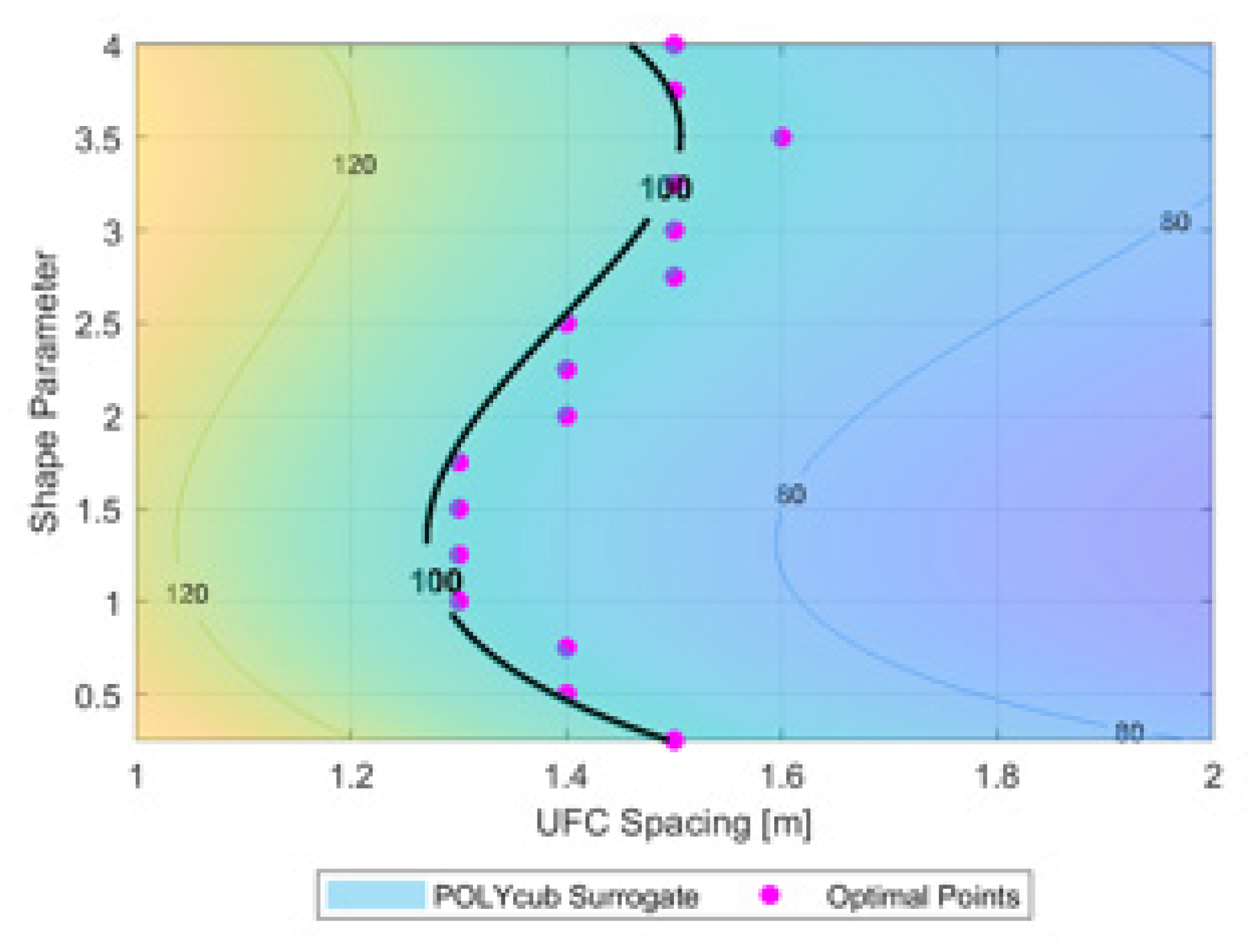
References
- Kwong, G.M. Status of Corrosion Studies for Copper Used Fuel Containers under Low Salinity Conditions; Nuclear Waste Management Organization: Toronto, ON, Canada, 2011. [Google Scholar]
- Scully, J.R.; Edwards, M. Review of the NWMO Copper Corrosion Allowance; Nuclear Waste Management Organization: Toronto, ON, Canada, 2013. [Google Scholar]
- Scully, J.R.; Féron, D.; Hänninen, H. Review of the NWMO Copper Corrosion Program; Nuclear Waste Management Organization: Toronto, ON, Canada, 2016. [Google Scholar]
- Noronha, J. Deep Geological Repository Conceptual Design Report: Crystalline/Sedimentary Rock Environment; Nuclear Waste Management Organization: Toronto, ON, Canada, 2016. [Google Scholar]
- Briggs, S.; Krol, M. Diffusive Transport Modelling of Corrosion Agents through the Engineered Barrier System in a Deep Geological Repository for Used Nuclear Fuel; Nuclear Waste Management Organization: Toronto, ON, Canada, 2018. [Google Scholar]
- Nuclear Waste Management Organization. RD 2019—NWMO’s Program for Research and Development for Long-Term Management of Used Nuclear Fuel; Nuclear Waste Management Organization: Toronto, ON, Canada, 2019. [Google Scholar]
- Guo, R. Thermal response of a Canadian conceptual deep geological repository in crystalline rock and a method to correct the influence of the near-field adiabatic boundary condition. Eng. Geol. 2017, 218, 50–62. [Google Scholar] [CrossRef]
- Kwon, S.; Cho, W.; Lee, J. An Analysis of the Thermal and Mechanical Behavior of Engineered Barriers in a High-Level Radioactive Waste Repository. Nucl. Eng. Technol. 2013, 45, 41–52. [Google Scholar] [CrossRef] [Green Version]
- Sizgek, G.D. Three-dimensional thermal analysis of in-floor type nuclear waste repository for a ceramic waste form. Nucl. Eng. Des. 2005, 235, 101–109. [Google Scholar] [CrossRef]
- Lin, S. Design Optimization of the Spacing Parameters in the Canadian Deep Geological Repository Containing High Level Radioactive Nuclear Waste. Master’s Thesis, University of Waterloo, Waterloo, ON, Canada, 2018. Available online: http://hdl.handle.net/10012/13934 (accessed on 9 October 2021).
- Zhou, X.-Y.; Sun, D.; Tan, Y.; Zhou, A. Canister spacing in high-level radioactive nuclear waste repository. Ann. Nucl. Energy 2020, 141, 107335. [Google Scholar] [CrossRef]
- Gobien, M.; Garisto, F.; Kremer, E.; Medri, C. Sixth Case Study: Reference Data and Codes; Nuclear Waste Management Organization: Toronto, ON, Canada, 2016. [Google Scholar]
- Baumgartner, P.; Tran, T.V.; Burgher, R. Sensitivity Analyses for the Thermal Response of a Nuclear Fuel Waste Disposal Vault; Atomic Energy of Canada Limited: Pinawa, MB, Canada, 1994. [Google Scholar]
- Tait, J.C.; Roman, H.; Morrison, C.A. Characteristics and Radionuclide Inventories of Used Fuel from OPG Nuclear Generating Stations; Ontario Power Generation, Nuclear Waste Management Division: Toronto, ON, Canada, 2000. [Google Scholar]
- Garisto, F. Sixth Case Study: Features, Events and Processes; Nuclear Waste Management Organization: Toronto, ON, Canada, 2017. [Google Scholar]
- Kumaraswamy, P. A generalized probability density function for double-bounded random processes. J. Hydrol. 1980, 46, 79–88. [Google Scholar] [CrossRef]
- Vu, K.K.; D’Ambrosio, C.; Hamadi, Y.; Liberti, L. Surrogate-based methods for black-box optimization. Int. Trans. Oper. Res. 2016, 24, 393–424. [Google Scholar] [CrossRef]
- McKay, M.D.; Beckman, R.J.; Conover, W.J. Comparison of Three Methods for Selecting Values of Input Variables in the Analysis of Output from a Computer Code. Technometrics 1979, 21, 239–245. [Google Scholar] [CrossRef]
- Mueller, J. MATSuMoTo: The MATLAB Surrogate Model Toolbox for Computationally Expensive Black-Box Global Optimization Problems. arXiv 2014, arXiv:1404.4261. [Google Scholar]
- Director, S.; Feldmann, P.; Krishna, K. Optimization of Parametric Yield: A Tutorial. In Proceedings of the IEEE Custom Integrated Circuits Conference, Boston, MA, USA, 3–6 May 1992; pp. 3.1.1–3.1.8. [Google Scholar]
- Seifi, A.; Ponnambalam, K.; Vlach, J. Optimization of filter designs with dependent and asymmetrically distributed parameters. J. Frankl. Inst. 2013, 350, 378–396. [Google Scholar] [CrossRef]
- Heimlich, D. APM 2016 Lifecycle Cost Estimate Update Summary Report; Nuclear Waste Management Organization: Toronto, ON, Canada, 2016. [Google Scholar]
- Statistics Canada. Table 32-10-0047-01 Value per Acre of Farm Land and Buildings at July 1; Statistics Canada: Ottawa, ON, Canada, 2021.
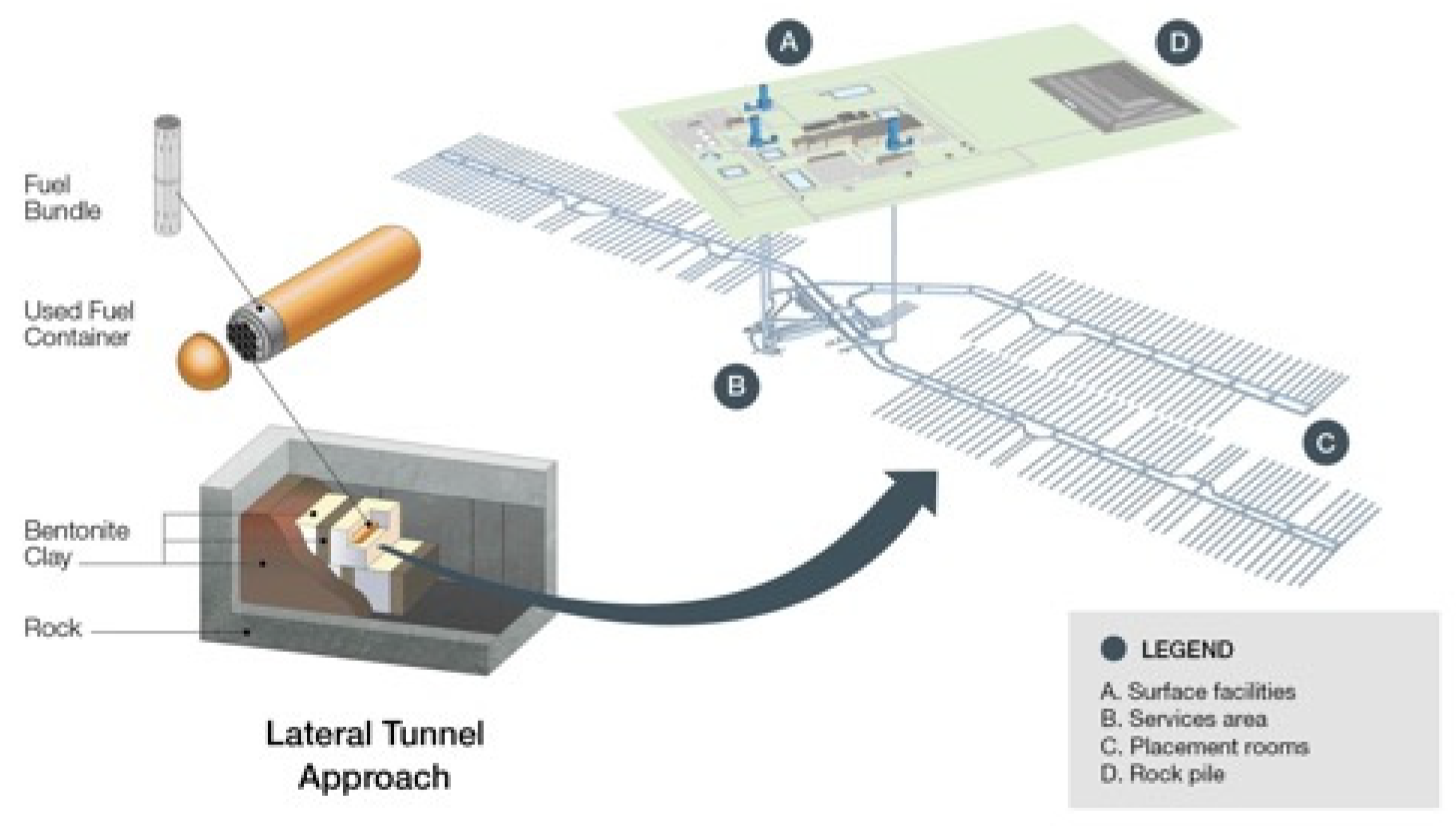

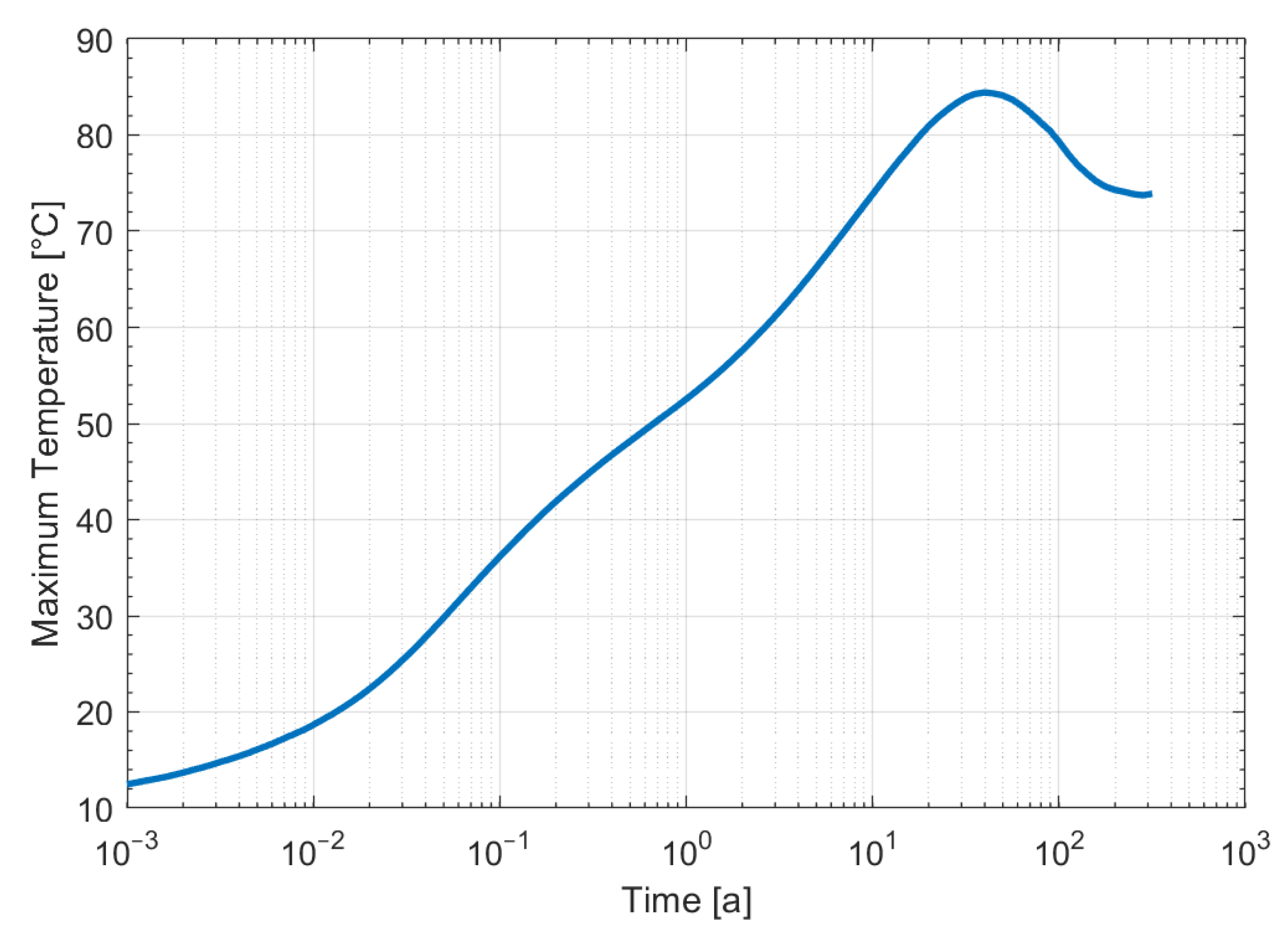
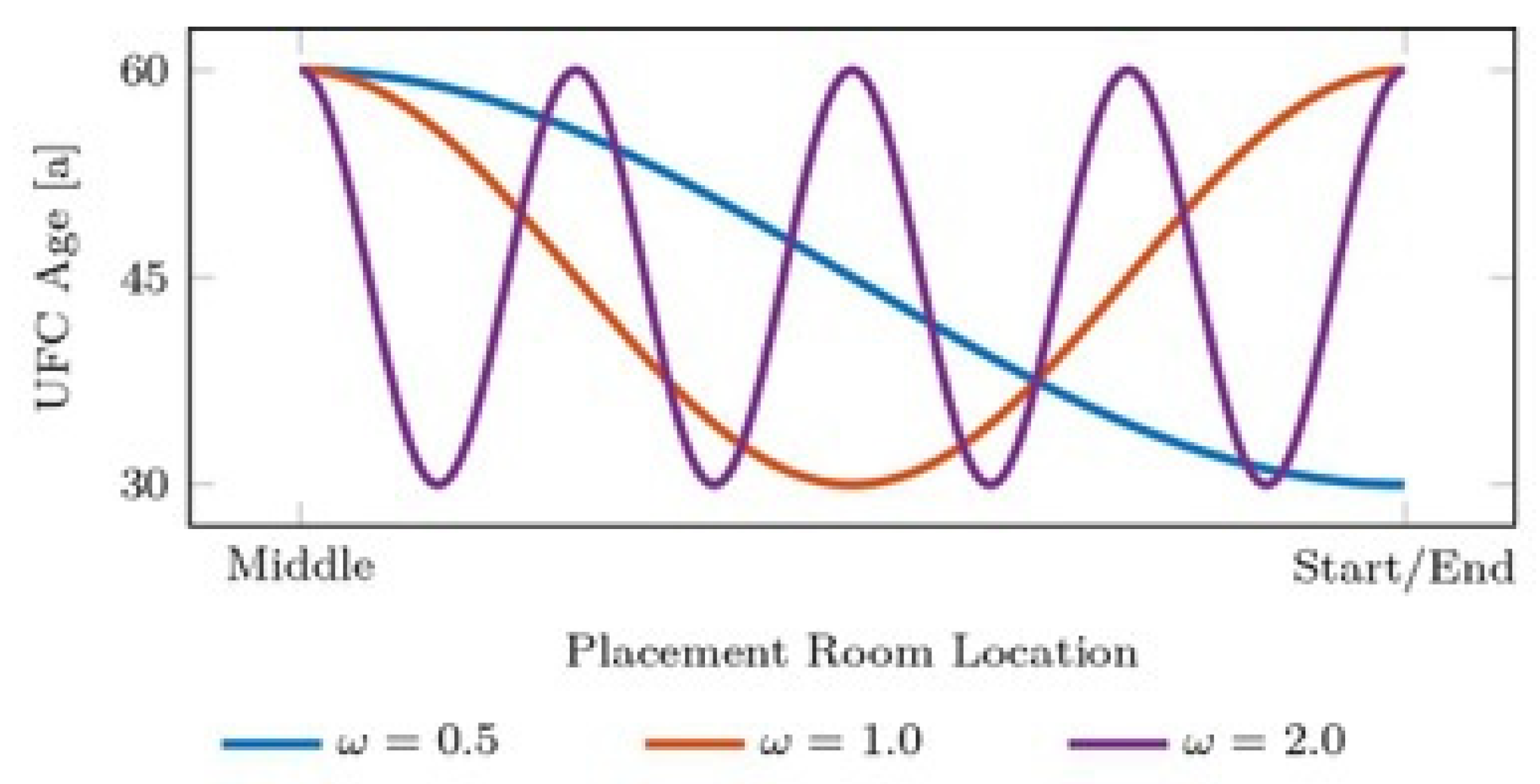
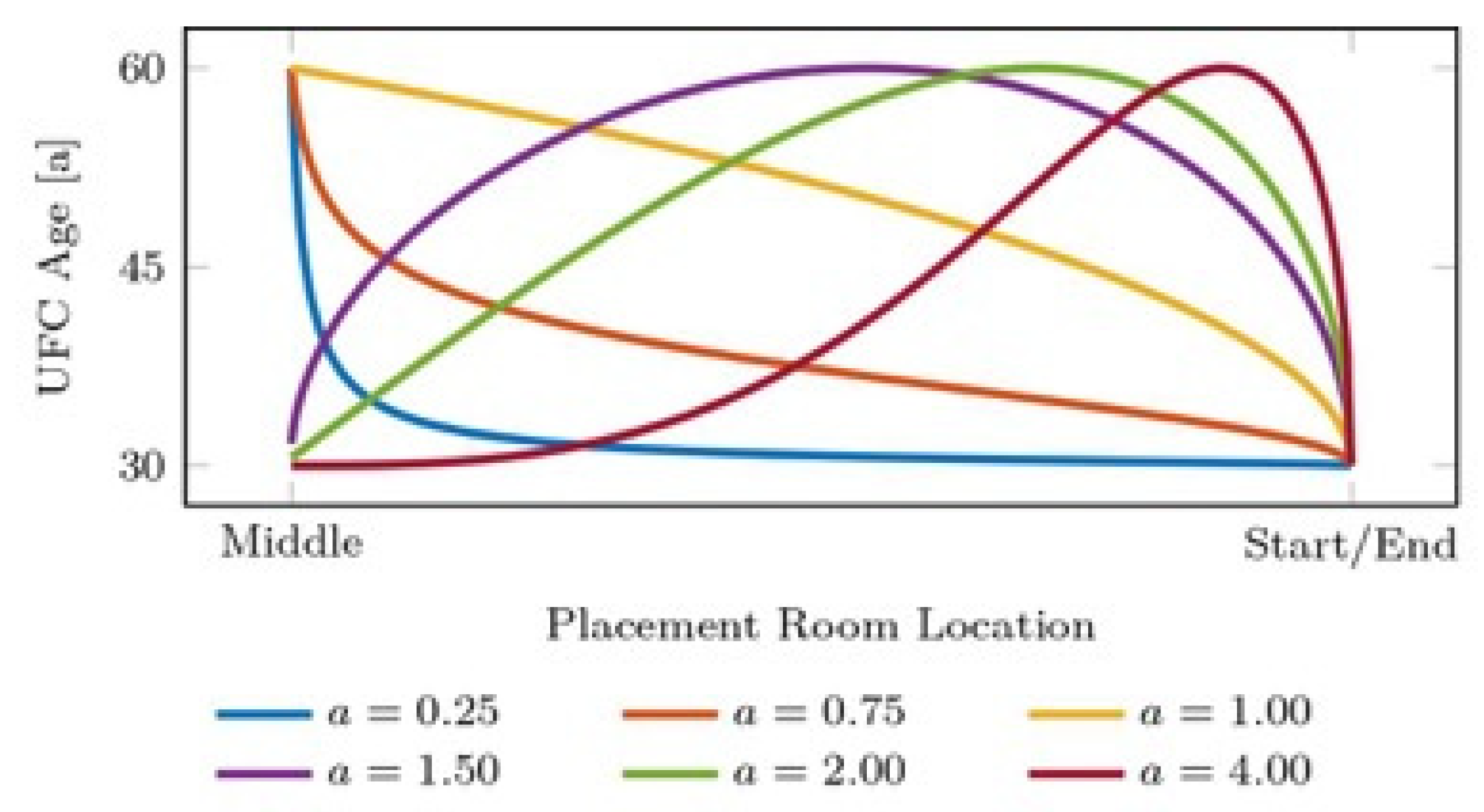
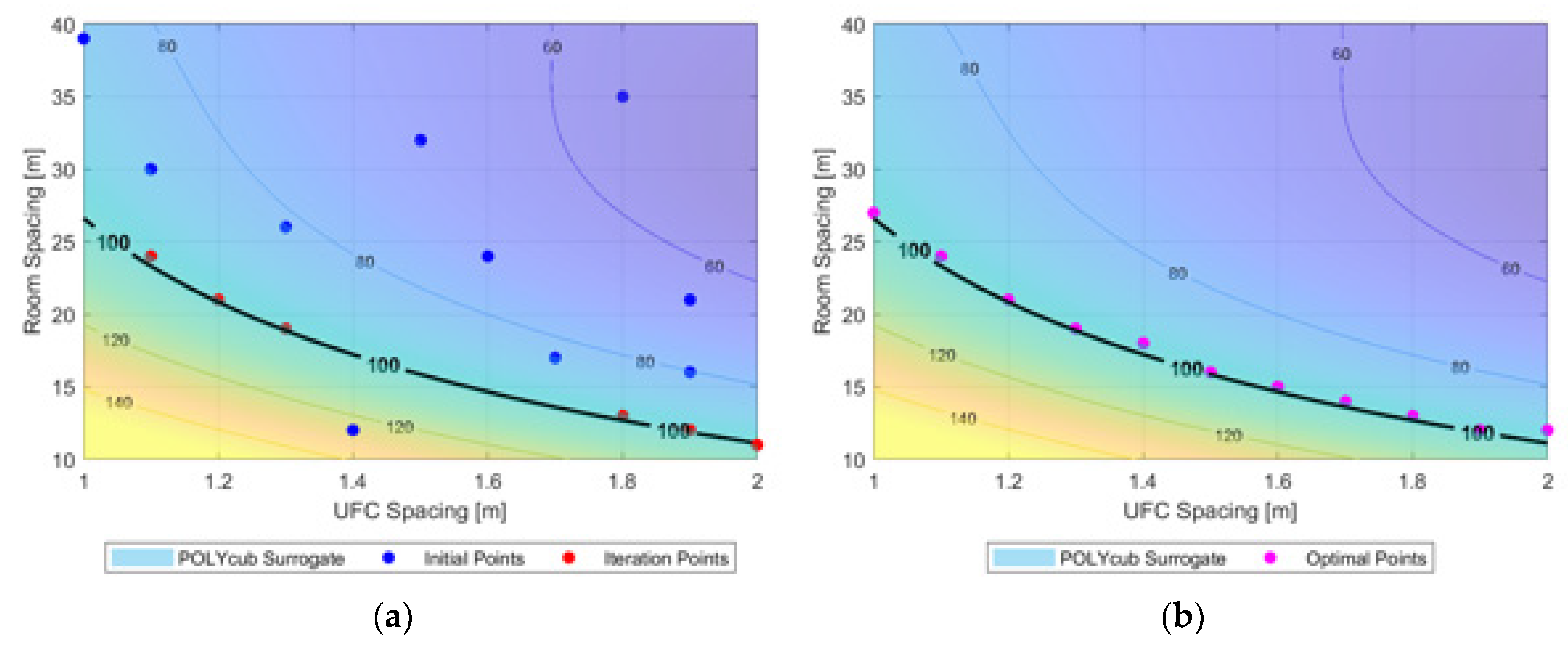


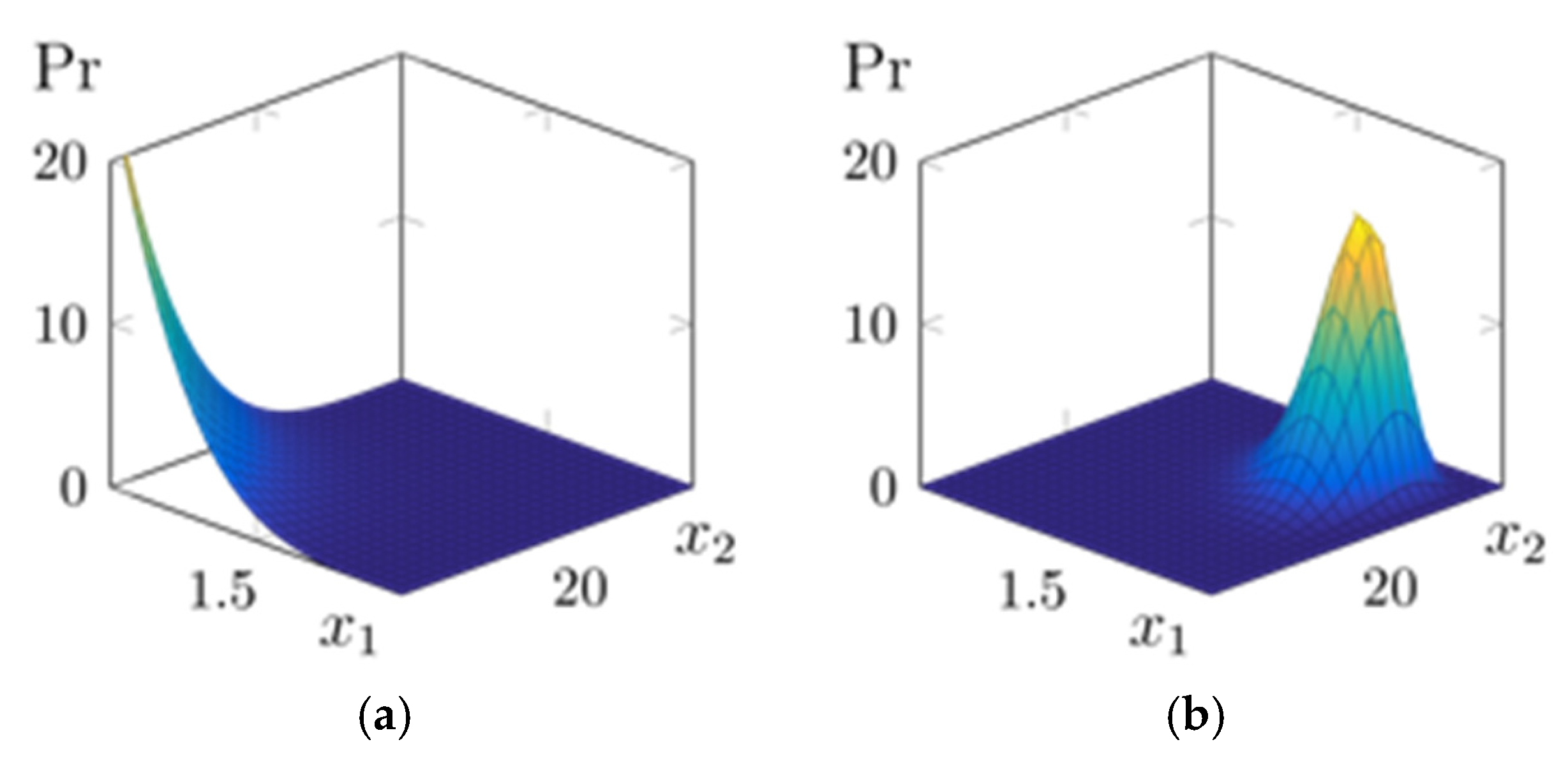
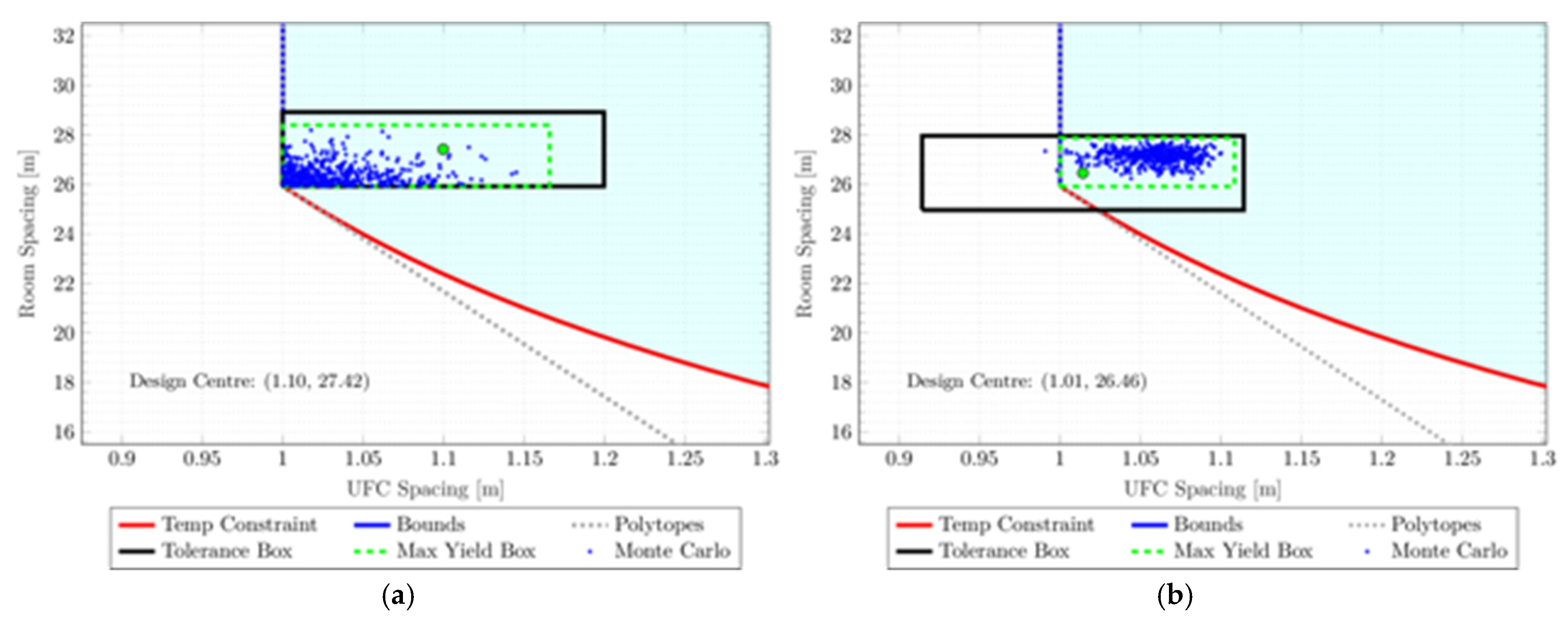

| Component | Bulk Density [kg/m3] | Thermal Conductivity [W/m/K] | Specific Heat Capacity [J/kg/K] |
|---|---|---|---|
| UFC | 7800 | 60.5 | 434 |
| Buffer Box | 1955 | 1.0 | 1280 |
| Spacer Block | 2276 | 2.0 | 1060 |
| Gap-Fill | 1439 | 0.4 | 870 |
| Host Rock | 2700 | 3.0 | 845 |
| Time Out-of-Reactor [a] | Heat Output [W] | Time Out-of-Reactor [a] | Heat Output [W] |
|---|---|---|---|
| 30 | 169.092 | 150 | 46.108 |
| 35 | 155.232 | 160 | 44.075 |
| 40 | 142.296 | 200 | 38.716 |
| 45 | 131.208 | 300 | 32.802 |
| 50 | 121.968 | 500 | 26.888 |
| 55 | 112.728 | 1000 | 18.665 |
| 60 | 105.336 | 2000 | 12.751 |
| 70 | 91.568 | 5000 | 9.240 |
| 75 | 85.932 | 10,000 | 6.644 |
| 80 | 80.850 | 20,000 | 3.844 |
| 90 | 72.257 | 35,000 | 2.097 |
| 100 | 65.327 | 50,000 | 1.321 |
| 110 | 59.783 | 100,000 | 0.380 |
| 135 | 49.988 | 1,000,000 | 0.137 |
Publisher’s Note: MDPI stays neutral with regard to jurisdictional claims in published maps and institutional affiliations. |
© 2021 by the authors. Licensee MDPI, Basel, Switzerland. This article is an open access article distributed under the terms and conditions of the Creative Commons Attribution (CC BY) license (https://creativecommons.org/licenses/by/4.0/).
Share and Cite
Leong, J.; Ponnambalam, K.; Binns, J.; Elkamel, A. Thermally Constrained Conceptual Deep Geological Repository Design under Spacing and Placing Uncertainties. Appl. Sci. 2021, 11, 11874. https://doi.org/10.3390/app112411874
Leong J, Ponnambalam K, Binns J, Elkamel A. Thermally Constrained Conceptual Deep Geological Repository Design under Spacing and Placing Uncertainties. Applied Sciences. 2021; 11(24):11874. https://doi.org/10.3390/app112411874
Chicago/Turabian StyleLeong, Jeremy, Kumaraswamy Ponnambalam, Jeff Binns, and Ali Elkamel. 2021. "Thermally Constrained Conceptual Deep Geological Repository Design under Spacing and Placing Uncertainties" Applied Sciences 11, no. 24: 11874. https://doi.org/10.3390/app112411874
APA StyleLeong, J., Ponnambalam, K., Binns, J., & Elkamel, A. (2021). Thermally Constrained Conceptual Deep Geological Repository Design under Spacing and Placing Uncertainties. Applied Sciences, 11(24), 11874. https://doi.org/10.3390/app112411874







